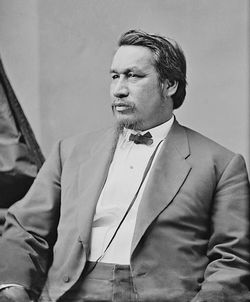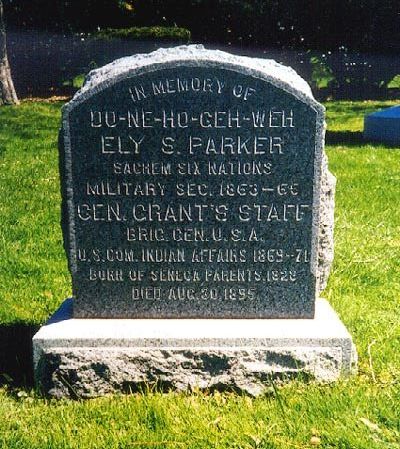He was born in Indian Falls, New York, and educated in two different cultures. He was a trained lawyer, but was barred from practicing in New York because of his race (on grounds of lack of citizenship). He also was a self-taught engineer.
He met Ulysses S. Grant before the Civil War in Galena, Illinois. Eager to join the Army, he was once rejected for military service because he was an Indian. In 1863, with Grant's support, he was commissioned as a staff officer for another friend from Galena, Brigadier General John E. Smith. He served as chief engineer of the 7th Division, XVII Corps, Army of Tennessee.
He became reacquainted with Grant during the Vicksburg campaign. He later served at Chattanooga, and, during the siege of Petersburg, he joined Grant's staff as military secretary with the rank of Lieutenant Colonel. There he was often derogatorily called "The Indian."
He was introduced to General Robert E. Lee in the parlor of the McLean House at Appomattox. Lee replied, "I am glad to see one real American here." Parker replied, "We are all Americans." Writing out the terms of surrender for Grant's signature, he had reached the height of his military career.
After the war, he continued as Grant's secretary until the beginning of Grant's presidency, serving as a Second Lieutenant in the 2nd Cavalry and still later as Colonel and aide-de-camp. He was brevetted Brigadier General in both the Volunteers and in the Regulars for the war. His brevet was backdated to the day of Lee's surrender.
In 1869, President Grant astounded the nation by appointing him Commissioner of Indian Affairs, a post never before deemed suitable for an Indian. He served as Chief of the six Iroquois Nations, consisting of the Tuscaroras, Cayugas, Senecas, Mohawks, Oneidas, and Onondagas.
Beset both by corrupt profiteers and overzealous churchmen, he was investigated by the House of Representatives. Exonerated, he resigned in sorrow and attempted a career in business, in which he was unsuccessful. Before his death in Fairfield, Connecticut, he sank into poverty and left his widow with no income and few possessions; those included, however, one of the valuable manifold (carbon) copies of the surrender he had written at Appomattox. He is buried near friends, Red Jacket, Little Billy, Young King, Tall Peter, Destroy Town, and Louis Bennett, also known as Deerfoot.
He was born in Indian Falls, New York, and educated in two different cultures. He was a trained lawyer, but was barred from practicing in New York because of his race (on grounds of lack of citizenship). He also was a self-taught engineer.
He met Ulysses S. Grant before the Civil War in Galena, Illinois. Eager to join the Army, he was once rejected for military service because he was an Indian. In 1863, with Grant's support, he was commissioned as a staff officer for another friend from Galena, Brigadier General John E. Smith. He served as chief engineer of the 7th Division, XVII Corps, Army of Tennessee.
He became reacquainted with Grant during the Vicksburg campaign. He later served at Chattanooga, and, during the siege of Petersburg, he joined Grant's staff as military secretary with the rank of Lieutenant Colonel. There he was often derogatorily called "The Indian."
He was introduced to General Robert E. Lee in the parlor of the McLean House at Appomattox. Lee replied, "I am glad to see one real American here." Parker replied, "We are all Americans." Writing out the terms of surrender for Grant's signature, he had reached the height of his military career.
After the war, he continued as Grant's secretary until the beginning of Grant's presidency, serving as a Second Lieutenant in the 2nd Cavalry and still later as Colonel and aide-de-camp. He was brevetted Brigadier General in both the Volunteers and in the Regulars for the war. His brevet was backdated to the day of Lee's surrender.
In 1869, President Grant astounded the nation by appointing him Commissioner of Indian Affairs, a post never before deemed suitable for an Indian. He served as Chief of the six Iroquois Nations, consisting of the Tuscaroras, Cayugas, Senecas, Mohawks, Oneidas, and Onondagas.
Beset both by corrupt profiteers and overzealous churchmen, he was investigated by the House of Representatives. Exonerated, he resigned in sorrow and attempted a career in business, in which he was unsuccessful. Before his death in Fairfield, Connecticut, he sank into poverty and left his widow with no income and few possessions; those included, however, one of the valuable manifold (carbon) copies of the surrender he had written at Appomattox. He is buried near friends, Red Jacket, Little Billy, Young King, Tall Peter, Destroy Town, and Louis Bennett, also known as Deerfoot.
Bio by: Ugaalltheway
Inscription
Sachem Six Nations
Military Sec. 1863-66
Gen. Grant’s Staff
Brig. Gen. U.S.A.
U.S. Com. Indian Affairs 1869-71
Born of Seneca Parents
Family Members
Advertisement
See more Parker memorials in:
Explore more
Sponsored by Ancestry
Advertisement










